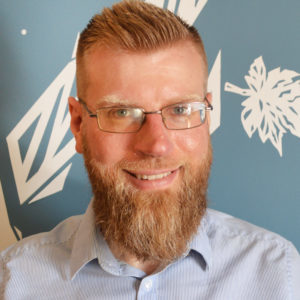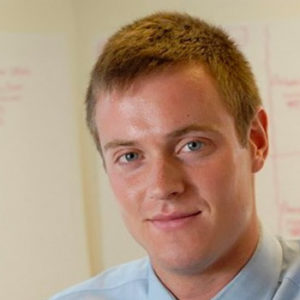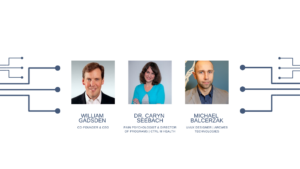In today’s episode of Product Hacker, we’re joined by Septa’s Director of Innovation, Erik Johanson. Johanson shares his ideology for successful innovation in a public company. We’ll learn about how their budget neutrality system pushed SEPTA to get creative, get sustainable, and remain profitable.


Kurt Schiller [00:00:01]: Welcome to Product Hacker, the Arcweb Business Innovation Podcast, we bring you the latest from the world of business innovation, from emerging technologies to game-changing ideas. Product Hacker connects you with the people and concepts that are changing the face of business. I’m your host, Arcweb Head of Marketing, Kurt Schiller.
Kurt Schiller [00:00:22]: If you’re in Philadelphia and work in healthcare, make sure to check out our “Healthcare Experience Engineers Meetup“. We feature guests and speakers who dig into the inner workings of designing healthcare experiences from a patient-centric perspective. For more information, search for “Healthcare Experience Engineers” on Meetup.
Kurt Schiller [00:00:41]: Welcome to Product Hacker, brought to you by Arcweb Technologies. I’m your host, Kurt Schiller.
Kurt Schiller [00:00:46]: Innovation is tough enough in the world of big business, but move the conversation to the public sector. And as a whole host of new and different challenges just waiting to trip up would-be innovators. Today, we’ll be digging into the ways innovation works in the world of government. From budget and politics to making sure you’re innovating for everyone, not just a select few. We’ll be joined by Erk Johanson, Head of Innovation for the Southeastern Pennsylvania Transit Authority, better known to locals as SEPTA, which provides regional mass transit for the entire Philadelphia area, including trolleys, buses, subways and commuter rail. Erik heads up SEPTA’s Innovation Team, which focuses on finding new ways to improve the agency’s operations and further its core missions of meeting the daily transportation needs of the city’s 1.5 million residents.
Kurt Schiller [00:01:28]: So to kind of set the stage for our discussion, could you give us an overview of the overall mission and goal for a SEPTA’s innovation department?
Erik Johanson [00:01:36]: Sure. So the Office of Innovation was created in 2015 on the heels of development of a five-year strategic business plan that we had developed earlier that year. And it was really developed in recognition of the fact that among the goals of the new strategic plan, innovation was probably the one that needed the most specific focus. And so a specific department was created to make sure that we were shepherding the various innovation initiatives that came out of the plan. So our mission statement, as it stated, is to both advocate for and work to build a collaborative corporate culture of innovation, team building, creative problem solving, database decision making and strategic performance management towards the achievement of SEPTA’s vision to become the region’s preferred choice for transportation. So that’s a long way of saying that we work with other departments throughout the organization to implement their innovation initiatives, their change management initiatives. We are a facilitator of innovation first and foremost, and we look to collaborate with groups across the organization that have good ideas.
Kurt Schiller [00:02:54]: So I want to dig into the way that that collaboration happens in a second. But before we do that, how big is the department? Are there any particular job roles or skill sets? Like what does that team look like?
Erik Johanson [00:03:05]: Sure. So we’ve got a team of six people. So I’m the director and we’ve got a program coordinator who keeps us all on track and as the glue that really holds the thing together. And then we have two managers of corporate initiatives and their role will be clearer when we talk about how we do what we do.
Erik Johanson [00:03:33]: And then we have two staff members that focus strictly on data and analytics, which is becoming a key part of our role within the organization and how we bring a business data-driven mindset to the initiatives that we’re working on.
Kurt Schiller [00:03:51]: So you mentioned that your role is really to facilitate innovation within other parts of SEPTA. Are the actual innovation projects, do they originate within the innovation department or are they rising up from different areas of SEPTA? And then you guys really bring them to life?
Erik Johanson [00:04:08]: Well, I guess the first thing I want to put out there is a way of answering that question. Is that the way that we define innovation maybe a little bit different than a way that some other organizations define it. We don’t just define innovation as a focus on initiatives. We are first and foremost focused on developing a culture of innovation.
Erik Johanson [00:04:36]: We believe the best way to innovate here at SEPTA is to unlock the ingenuity and the skills and the know-how of people across the organization to do their own innovating.
Erik Johanson [00:04:53]: And so our approach to innovation is is fundamentally rooted in the fact that we’ve failed if the only place that innovation is happening is from the six of us. So we do have some initiative-focused work with staff that work with cross-departmental teams that we refer to as innovation teams. But we also do a series of other things that are– what I would call towards a culture of innovation. We manage a process that we call SEPTA stat where we work with each of the divisions across the organization to come up with key performance indicators to measure and manage performance improvements. We serve as a sort of de facto internal consultant to other departments when they have change management initiatives that they want to pursue. So there’s a variety of different roles that we’ve played. But first and foremost, our function is not just innovation initiatives per se, but to foster and grow a culture of innovation.
Kurt Schiller [00:06:02]: Makes a lot of sense. Yeah, we’ve talked a lot about intrapreneurship and in some of the other Product Hacker related discussions that we’ve had about ways that companies can really kind of tap into that innovative potential that’s within exactly, as you said, areas of the company or an organization that aren’t directly part of the innovation initiative. So what are some of the mechanisms that your team uses to foster that culture of innovation?
Erik Johanson [00:06:31]: So I mentioned performance management. I mean we’re– we have a pretty substantial effort to try to create a data-driven decision-making process within the organization through this through the SEPTA stat program. And what comes out of that often are new initiatives to try to affect performance improvements. Often times these different aspects of what we do as teamwork together. So something that’ll come out of SEPTA stat will result in a study, you know, the Office of Innovation facilitates to go look at best practices in how an issue is being addressed.
Erik Johanson [00:07:15]: You know, just to a good recent example of a win that we have had is for years as an organization, we had carried a backlog of firms that were applying for a certification through SEPTA to become a disadvantaged business enterprise recipient. It’s a designation that allows you to participate in the achievement of federal goals towards the improvement of minority and women-owned businesses. So we carried a backlog because we had a volume of applications that were coming in that was larger and faster than we were able to process. So our department worked with the DBE Program Office to develop a menu of scenarios and options for reducing that backlog.
Erik Johanson [00:08:09]: And within a year of producing that report, last week, the backlog was gone. So that’s just one example of a way that we’ve come alongside another department and worked with them to assess a problem, bring them best practices and then work with them to achieve the results that are desired.
Building a digital product?
Kurt Schiller [00:08:32]: Gotcha. So it was that one of the programs that came out of the SEPTA stat program?
Erik Johanson [00:08:37]: Correct. Yeah, so the way SEPTA stat works is we have quarterly meetings with the general manager of SEPTA and the divisional heads and oftentimes their direct reports.
Erik Johanson [00:08:52]: And, you know, they give an accounting of their performance from the past quarter. And the Office of Innovation is present and what often comes out of those meetings is a certain degree of prioritization of focus for future meetings. And what came out of the meeting with our DBE office, which is a part of our procurement division, was a real focus on reducing that backlog. And so after one of those SEPTA stat meetings, we transitioned into being a consultant to the DBE program office and worked with them to address the issue.
Kurt Schiller [00:09:29]: So when you start a consulting role like that, is there a defined timeframe in which that engagement is going to happen or is it really just until the projected or until the problem is addressed?
Erik Johanson [00:09:41]: You know, it’s a great question and it’s something I’m starting to spend a lot of time thinking about is, as we’ve sort of gotten some successes under our belt and proven our worth to different departments, we’ve had to start to think about our staffing levels and the sustainability of our ability to continue on with projects, not only during the process by which you come up with the ideas, but also the process by which you implement them.
Erik Johanson [00:10:13]: I’d say that that’s still a work in progress. And coming up with some more defined terms of engagement is something that hadn’t really previously been an issue because we’re still being somewhat entrepreneurial about the types of work that we were doing. But now that we’ve got a little bit more demand for our work, we’ve got to start thinking about putting some structures in place to manage it.
Kurt Schiller [00:10:38]: As a member of the riding public, of which I certainly am. I’m on regional rail pretty much every day in both directions along the subway. Probably one of the most visible aspects of change is that at SEPTA is when new technology gets introduced. Could you talk a little bit about how the innovation department and the culture of innovation evaluates new technologies? Is there any particular approach to saying, yes, there’s potential here, or is it really a viewing technology as tools and trying to bring that up organically as an opportunity is identified?
Erik Johanson [00:11:14]: So, I mean, obviously, there’s a technological component to everything that we do. The technologies that are being pushed out from SEPTA right now are definitely examples of innovation and action.
Erik Johanson [00:11:29]: I mean, the SEPTA key is a state of the art fair payment system, open payment. It’s one of a half dozen types of fare card systems like it not just in the country, but across the world. Those types of projects are typically managed within their own departmental structures and outside the framework of what the Office of Innovation does. Where the Office of Innovation would come alongside a project like that is advocating in certain ways for a series of strategic priorities and principles for how that technology is rolled out. So, for example, one of the innovation teams that we staff is called the Ridership Growth Innovation Team.
Erik Johanson [00:12:18]: And so what that team is responsible for doing is looking at the cultural elements of the organization, the practices of the organization and the initiatives that the organization and how those things align with the strategic priority to grow ridership. And so what the team does is essentially attempt to work with various technology initiatives like SEPTA Key, like the new mobile app with the real-time information that we’re providing about vehicle location and make sure that those things are designed in such a way that they’re able to encourage ridership and maximize their value in so doing. It’s more of a cultural angle to the initiative rather than the implementation of the initiative itself.
Kurt Schiller [00:13:08]: That makes a lot of sense– that actually segways pretty nicely into another question I had, which is, you know, obviously SEPTA is this is a very large undertaking and it’s something that touches people’s lives and in a ton of different ways from terms of, you know, getting them to work, getting them to see loved ones. Are there any unique challenges within trying to do innovation on this massive system that is so intrinsic towards people’s lives, including, you know, a lot of vulnerable populations?
Erik Johanson [00:13:38]: Yeah, I mean, the way that we have defined innovation is really to take the long view on those types of things and on those challenges and find ways that we can continue to improve as an organization and continue to provide a better quality service. So, you know, the sorts of constraints that you’re talking about, those just sort of go into the overall decision-making process. The most obvious constraint is, is funding, right? I mean, you don’t have an unlimited amount of money to do everything you want to do. So how do you maximize the utility of what you do have funding for and make it work for you? So I’ll give you the example of our sustainability program.
Erik Johanson [00:14:25]: We’ve had a board adopt a sustainability program since 2011, and the sustainability program has gotten national recognition for its ability to drive down carbon emissions, improve stormwater management, increase recycling rates for working on the second-largest solar project in the history of the city of Philadelphia right now. We’ve got 10 megawatts of battery storage capacity and we’ve rolling out our first fleet of battery-electric buses this fall. By next year, we’ll have the largest fleet of battery-electric buses on the East Coast.
Erik Johanson [00:15:02]: We’ve done all of these things without having a budget for sustainability. What the board adopted for us back in 2011 was a program founded on the principle of budget neutrality, which means that the projects that we implement have to either bring their own money to the table through grants or some sort of innovative financing mechanism or new revenue. And they have to have a business case. So there has to be a return on investment. So, you know, with all of these projects, what we found is with a lot of the projects, not all of them and some projects we’ve had to punt on because it didn’t have a business case. We found that there’s a solid business reason to do them. And so with sustainability, I think what we’re finding is that, you know, the constraints on funding have forced us to be more creative about how we implement projects.
Erik Johanson [00:16:10]: So the Battery Electric Bus Program, we submitted a grant app– two grant applications to the federal government and received funding for the incremental cost above and beyond the buses that we currently buy to buy the battery-electric buses. So from the perspective of our board in our capital program, it was budget neutral because there is no additional money going into the additional service. With our battery storage project, we did a public-private partnership with Constellation, a large energy company where they financed the project and they’re actually paying us rent for access to our substations in exchange for a share of the revenue that comes from the energy that’s stored in the batteries. So all of this has been done sort of off-budget and through separate funding and financing mechanisms that have helped us focus the funding that we do have on our core business of moving people and our efforts to keep fares low and things like that while still implementing these pretty sophisticated cutting edge sustainability initiatives.
Kurt Schiller [00:17:24]: I think that’s a really interesting distinction that maybe is just part of SEPTA being a public organization. And I think a lot of private companies would just say, here’s this project that we’re going to roll out and here’s the cost. You wouldn’t see that inclusion of novel funding and budgetary mechanisms like renting out part of the project to make it budget neutral.
Erik Johanson [00:17:43]: In the mission of public transportation, which is both a public service and a business. We have the mandate to both operate as a subsidized public service, as a government entity. But we also have a mandate to operate with business-like efficiency. And so what I think that we found is, at least with sustainability. And I think what a lot of the other innovation initiatives that we’ve been working on, that there is a way to make those two things not mutually exclusive. To make ourselves more efficient, make ourselves operate more like a business, while also protecting and even enhancing our ability to serve the public.
Kurt Schiller [00:18:37]: That makes a lot of sense. And I guess that transitions pretty nicely into my last question, which you’ve already sort of addressed, but I’ll ask it anyway. If we were to jump ahead five years and look back at the activities of your innovation team, what would success look like?
Erik Johanson [00:18:51]: That’s a great question, and I guess I should spend a lot more time thinking about it. I don’t have like a nice package answer for that because, you know, as I said earlier, we’ve taken the long view, we’ve taken the perspective that our job is to build a culture of innovation at SEPTA. And that’s not going to happen overnight.
Erik Johanson [00:19:15]: And it’s certainly not going to happen as if we view our role as to be the innovators. People have great ideas at SEPTA. I mean, my measure of success is when we’re able to implement a great idea that someone has, we’re able to help them get that idea over the finish line. I think that one of the things that I’d really like to see is the translation of some of these initiatives back to core business outcomes. I really like to see innovation initiatives that result directly in ridership growth, that result directly in improvements to safety culture, that result directly into carbon footprint reductions towards sustainability goals.
Erik Johanson [00:20:07]: So I think that’s success to me sort of becomes innovation is just another way of describing how we do business at SEPTA. It’s not a thing unto itself, but it becomes a principle by which we work. And I think that’s been part of the success that we’ve had in some of the other cross-cutting corporate initiatives like sustainability, like our safety culture initiative, is that people have just sort of seen it as the way they do their day-to-day jobs. So I think success would be some combination of that for innovation, but also that the innovation initiatives that we are working on are able to be directly translated into key strategic objectives for the organization like growing ridership.
Kurt Schiller [00:21:02]: Well, thanks so much for taking the time to talk to us today, Eric. It’s been a pleasure having you on the show.
Erik Johanson [00:21:06]: Thanks for having me.
Kurt Schiller [00:21:08]: Thanks for joining us today. Next time, we’ll be digging into the ethical ramifications of product design. How did you make sure that your products are doing right by your users? And what should you do if you discover they’re not?
Kurt Schiller [00:21:19]: Product Hacker is brought to you by Arcweb Technologies, a digital design and development firm in Old City, Philadelphia. To learn more, visit Arcwebtech.com. The show is hosted by Kurt Schiller and produced by Martin Schneider. As always, thanks for listening. And don’t forget to like and subscribe.



